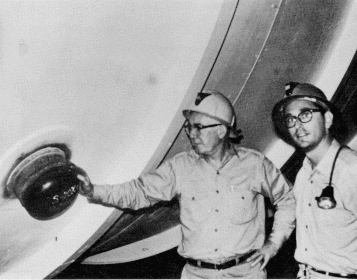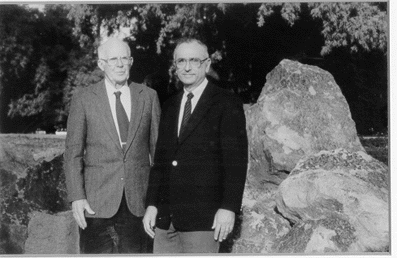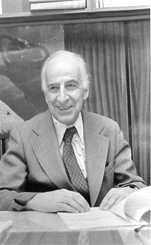 Solving the Mystery of the Missing Neutrinos
Solving the Mystery of the Missing Neutrinos
 Solving the Mystery of the Missing Neutrinos
Solving the Mystery of the Missing Neutrinos
 pdf
file
html
file
pdf
file (Italian translation)
pdf
file
html
file
pdf
file (Italian translation)
 Solar Models: An Historical Overview
Solar Models: An Historical Overview
 predict solar neutrino fluxes and then describe the current
uncertainties in the predictions. I will dispel the misconception that
the p-p neutrino flux is determined by the solar luminosity and
present a related formula that gives, in terms of the p-p and 7Be
neutrino fluxes, the ratio of the rates of the two primary ways of
terminating the p-p fusion chain. I will also attempt to explain why
it took so long, about three and a half decades, to reach a consensus
view that new physics is being learned from solar neutrino
experiments. Finally, I close with a personal confession.
predict solar neutrino fluxes and then describe the current
uncertainties in the predictions. I will dispel the misconception that
the p-p neutrino flux is determined by the solar luminosity and
present a related formula that gives, in terms of the p-p and 7Be
neutrino fluxes, the ratio of the rates of the two primary ways of
terminating the p-p fusion chain. I will also attempt to explain why
it took so long, about three and a half decades, to reach a consensus
view that new physics is being learned from solar neutrino
experiments. Finally, I close with a personal confession.
 Solar Neutrinos. I. Theoretical
Solar Neutrinos. I. Theoretical
Only neutrinos, with their extremely small interaction cross sections, can enable us to see into the interior of a star and thus verify directly the hypothesis of nuclear energy generation in stars. In this note, we predict the number of absorptions of solar neutrinos per terrestrial 37Cl atom by combining results of recent theoretical investigations of the solar neutrino fluxes with calculations of the relevant neutrino absorption cross sections on 37Cl.
 Solar Neutrinos. II. Experimental
Solar Neutrinos. II. Experimental
The prospect of observing solar neutrinos by means of the inverse beta process 37Cl(νe-)37Ar induced us to place the apparatus previously described in a mine and make a preliminary search. This experiment served to place an upper limit on the flux of extraterrestrial neutrinos. These results will be reported, and a discussion will be given of the possibility of extending the sensitivity of the method to a degree capable of measuring the solar neutrino flux calculated by Bahcall in the preceding paper.
 IAS's
Science Watch interview (1995)
IAS's
Science Watch interview (1995)
Science Watch Interviews of Featured Scientists in 1995. This is the text of an interview of John Bahcall by Science Watch's Physics correspondent Simon Mitton.
 How
the Sun Shines
How
the Sun Shines
|
postscript file pdf file pdf file (Italian) |  |
Here is the opening paragraph.
What makes the sun shine? How does the sun produce the vast amount of energy necessary to support life on earth? These questions challenged scientists for a hundred and fifty years, beginning in the middle of the nineteenth century. Theoretical physicists battled geologists and evolutionary biologists in a heated controversy over who had the correct answer.
The article traces in non-technical language the historical development of our understanding of nuclear fusion reactions as the source of stellar energy, beginning with the controversy over the age of the sun and earth between Darwin and Kelvin, and including the discovery of radioactivity, the experimental demonstration that four hydrogen nuclei are heavier than a helium nucleus, and the theoretical insights provided by Einstein, Gamow, and Bethe. The concluding sections concern solar neutrino experiments that were designed to test the theory of stellar evolution and which, in the process, apparently revealed new aspects of microscopic physics.
 The
Evolution of Neutrino Astronomy
The
Evolution of Neutrino Astronomy
How did neutrino astronomy evolve? Are there any useful lessons for astronomers and physicists embarking on new observational ventures today? We will answer the first question from our perspective. You, the reader, can decide for yourself whether there are any useful lessons.

 An account
of the development of the solar neutrino problem
An account
of the development of the solar neutrino problem
[For a brief appreciation of the contributions of Ray Davis to this subject, see the article entitled ``Ray Davis: The Scientist and the Man,'' which is the following selection on this page.]
This article summarizes from our personal perspective the history and development of what came to be known as ``the solar neutrino problem''. It begins with a brief description of what was known about nuclear fusion and solar neutrinos prior to 1962, when Ray Davis and I first began to collaborate, and then continues chronologically, giving our views about the major results and developments from 1962 until 1980, when the article was submitted for publication.
Science is a social activity and we recount here some of the social factors that seemed to us to be most important in shaping the way the subject grew.
History is usually written by a single author. Here is how we explained in the introduction why we chose to collaborate on this historical account.
``Theory and observation depend upon each other for their significance in solar neutrino research. Without a well-defined predicted counting rate the observed number of captures per day loses most of its meaning. Similarly, the theoretical work derives its motivation from the possibility of observational tests. The calculations required for this problem are detailed, precise, and specific; they are not necessary in making the general comparisons with observations that are appropriate for most other work in stellar evolution research. This synergism between theory and observation in solar neutrino work can be contrasted with the situation in a number of other astronomical fields whose initial development occurred during the period described here. The discoveries of quasars, infrared sources, radio pulsars, x-ray sources, and interstellar molecules all had immediate and obvious significance independent of previous theoretical work. The interdependence of solar neutrino theory and observation has been clearly recognized by the funding agencies. Because of this interdependence, we have found it natural to describe the combined history of the subject as we remember it.''
 Ray Davis: The Scientist and the Man
Ray Davis: The Scientist and the Man
This talk describes Ray Davis's principal scientific achievement, the discovery of solar neutrinos, and his uniquely admirable personality. The talk was presented as the opening lecture at a day long session on solar neutrino research dedicated to Ray in celebration of his 80th birthday.
 Neutrinos from the sun
Neutrinos from the sun
This article shows the state of thinking about solar neutrinos in 1969, the year following the first report of a low measured event rate in the chlorine Homestake experiment. Most of the main ideas about solar neutrino production are discussed in this early Scientific American article. The most notable absences are: resonant neutrino oscillations (the so-called MSW effect, which revolutionized thinking about the subject in 1985, see articles by Wolfenstein and by Mikheyev and Smirnov in `Solar neutrinos: the first thirty years') and helioseismology (which greatly strengthened confidence in the solar model predictions in the period 1995-1997, see BP95 and `Are Standard Solar Models Reliable?'). The beautiful solar neutrino experiments Kamiokande, GALLEX, SAGE, Superkamiokande, SNO, and BOREXINO were no where on the horizon in 1969.
Here is how I summarized in 1969 the results of the first experiment: ``The initial results published by Davis and his co-workers have left astronomers and astrophysicists somewhat puzzled because the neutrino flux rate seems somewhat low. It is less than half the theoretical value one obtains by assuming certain ``standard'' values for quantities used in constructing theoretical models of the solar interior.'' Note that this summary does not mention that physicists were encouraged to think about new neutrino properties that might explain the results. In fact, practically no one was thinking in that direction in the early days.
Toward the end of the Scientific American article, I briefly describe the idea of neutrino oscillations in vacuum. ``...The most imaginative idea has come from the U.S.S.R., where V. N. Gribov and B. Pontecorvo (who originally suggested the use of 37Cl to trap neutrinos) have proposed that neutrinos have a kind of double identify: approximately half the time they are the ordinary `electron neutrinos' we suppose them to be but half the time they are `muon neutrinos.' ...'' The conlcusion of this sole paragraph on neutrino oscillations is amusing in retrospect: ``...It will not be easy to test this unusual hypothesis, but it cannot be lightly dismissed.''
Original abstract. A giant trap has been set deep underground to catch a few of the neutrinos that theory predicts should be pouring out of the sun. Their capture would prove that the sun runs on thermonuclear power.
 Solar neutrinos: a scientific puzzle
Solar neutrinos: a scientific puzzle
 This review article, written more than 20 years ago, is of interest to
see how the nature of the solar neutrino problem has evolved over the
past two decades. The article
summarized the first 15 years of efforts to ``...understand and
test the theory of how the sun produces its radiant energy (observed
on the earth as sunlight).'' We described the existence of ``...a
large, unexplained disagreement between observation and the supposedly
well established theory.'' We concluded: ``This discrepancy has led to a
crisis in the theory of stellar evoluation...'' An experiment
utilizing 71Ga is described briefly as a possible way of
understanding the origin between theory and observation.
It is instructive to ask: To what extent do the arguments of this
paper appear valid today, two decades later?
This review article, written more than 20 years ago, is of interest to
see how the nature of the solar neutrino problem has evolved over the
past two decades. The article
summarized the first 15 years of efforts to ``...understand and
test the theory of how the sun produces its radiant energy (observed
on the earth as sunlight).'' We described the existence of ``...a
large, unexplained disagreement between observation and the supposedly
well established theory.'' We concluded: ``This discrepancy has led to a
crisis in the theory of stellar evoluation...'' An experiment
utilizing 71Ga is described briefly as a possible way of
understanding the origin between theory and observation.
It is instructive to ask: To what extent do the arguments of this
paper appear valid today, two decades later?
 Astrophysical
Neutrinos: 20th Century and Beyond
Astrophysical
Neutrinos: 20th Century and Beyond
I summarize the first four decades of solar neutrino research and suggest what may be possible to learn with extragalactic neutrinos and with solar neutrinos in the next decade.

 Letter from Bruno Pontecorvo in 1972
Letter from Bruno Pontecorvo in 1972
Pontecorvo remarks with regard to the latest results of the chlorine experiment of Ray Davis: "It starts to be really interesting! It would be nice if all this will end with something unexpected from the point of view of particle physics. Unfortunately, it will not be easy to demonstrate this, even if nature works that way."
This letter is published in the proceedings of the 23rd Johns
Hopkins Workshop on Current Problems in Particle Theory,
Neutrinos in the Next Millennium, Baltimore, June 10--12, 1999
(World Scientific, Singapore 2000), pp. 91-112.
 Searching for Neutrinos Beyond the Textbooks
Searching for Neutrinos Beyond the Textbooks
 Ulrich's Explanation for the Solar
Five Minute Oscillations
Ulrich's Explanation for the Solar
Five Minute Oscillations

This article introduces the reprint of the landmark paper ``The
Five-Minute Oscillations on the Solar Surface'' by R. K. Ulrich,
ApJ, 162, 993 (1970). In this paper, Ulrich
hypothesized-contrary to the then prevailing opinion-that the
oscillatory phenomena seen on the surface of the sun were the result
of waves propagating in the solar interior and derived the key
prediction that led to the field of helioseismology.
 Back to John Bahcall Popular Papers
Back to John Bahcall Popular Papers